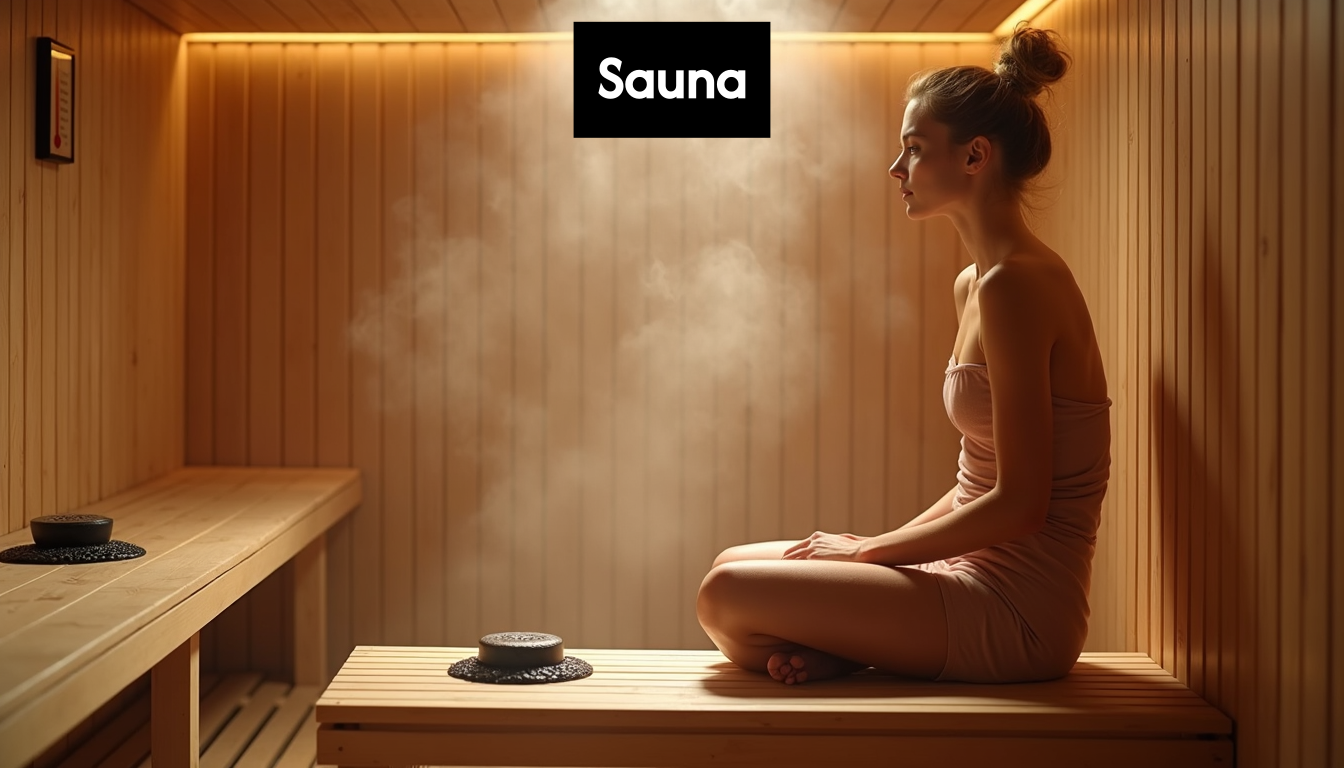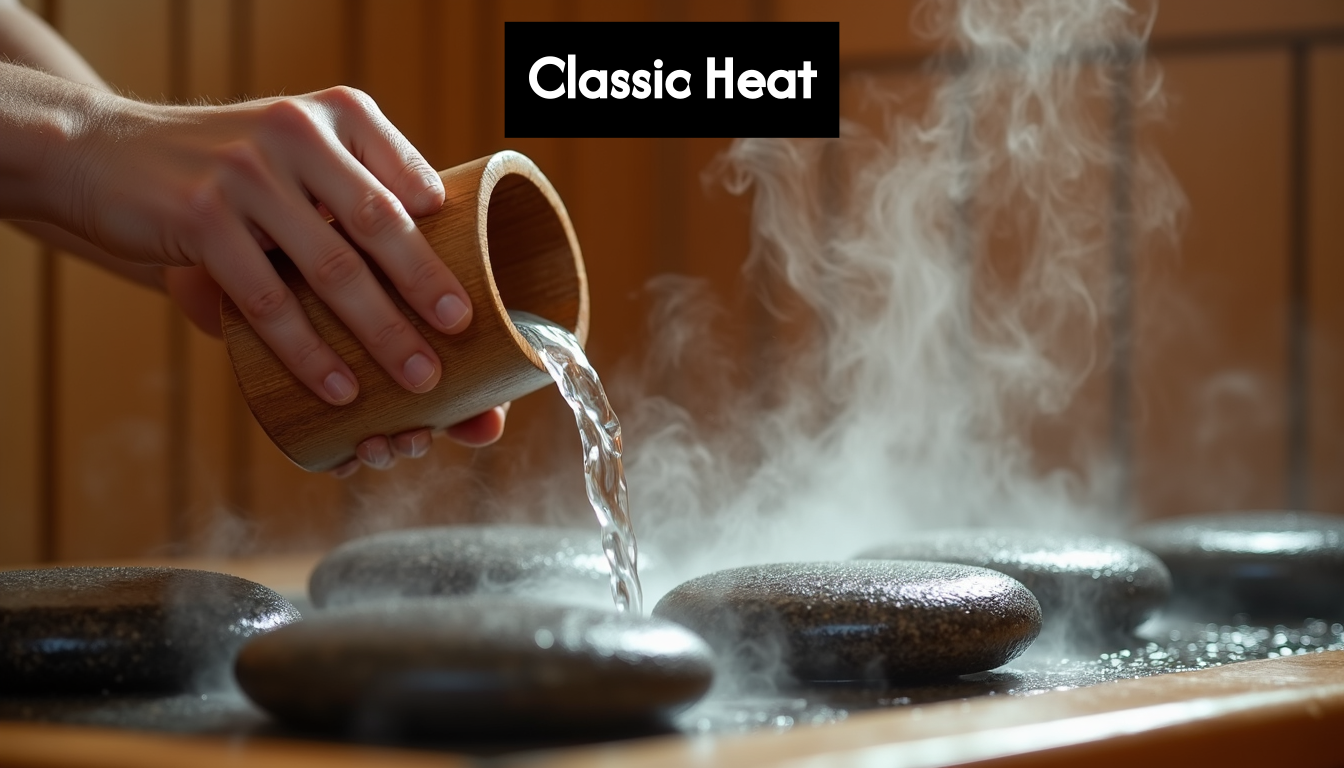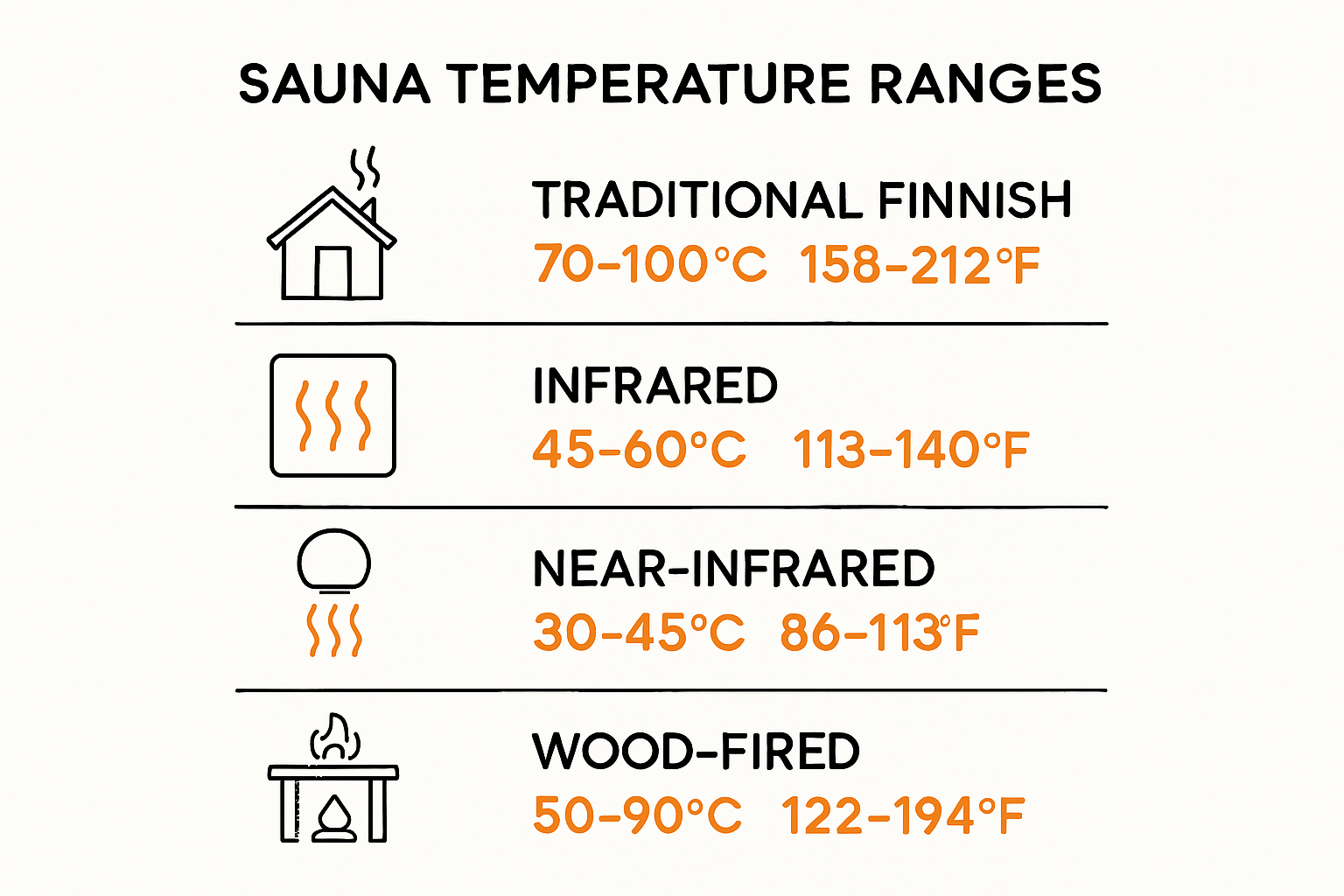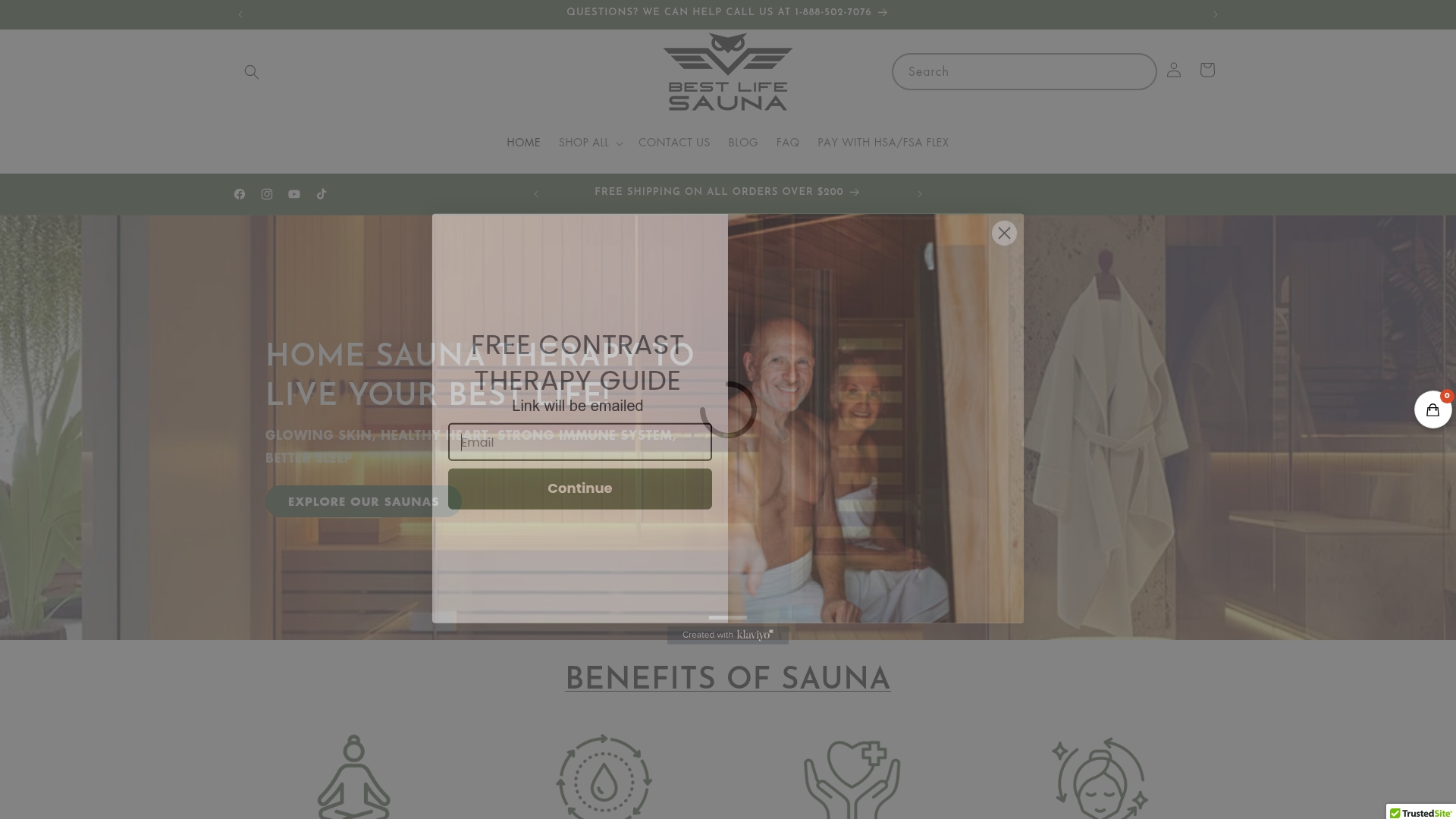
Best Sauna Temperature Settings for Wellness & Safety
 Sauna enthusiasts know the heat can be a game changer for health. Traditional saunas typically operate at temperatures between 70°C and 100°C, while infrared saunas function effectively at lower ranges of 38°C to 65°C. Yet, here’s the twist: many people mistakenly assume the higher the temperature, the better the benefits. In reality, the key to a truly rejuvenating sauna experience lies in finding your personal comfort zone. This means understanding your unique heat tolerance, which can greatly enhance both safety and wellness.
Sauna enthusiasts know the heat can be a game changer for health. Traditional saunas typically operate at temperatures between 70°C and 100°C, while infrared saunas function effectively at lower ranges of 38°C to 65°C. Yet, here’s the twist: many people mistakenly assume the higher the temperature, the better the benefits. In reality, the key to a truly rejuvenating sauna experience lies in finding your personal comfort zone. This means understanding your unique heat tolerance, which can greatly enhance both safety and wellness.
Table of Contents
- What Is Optimal Sauna Temperature?
- Sauna Types And Temperature Ranges
- Adjusting Sauna Heat For Safety
- Finding Your Comfortable Sauna Setting
Quick Summary
| Takeaway | Explanation |
|---|---|
| Optimal Temperature Range | Traditional saunas operate best between 70°C to 100°C (158°F to 212°F), while infrared saunas offer effective heat therapy between 38°C to 65°C (100°F to 149°F). |
| Session Duration for Benefits | Most health experts recommend 15-20 minute sauna sessions to maximize cardiovascular, stress reduction, and metabolic benefits. |
| Personalization is Key | Individual factors like age, health status, and heat tolerance significantly influence the ideal sauna temperature, necessitating a tailored approach. |
| Hydration is Essential | Drink water before, during, and after sauna use to maintain hydration and electrolyte balance, especially when exposed to high temperatures. |
| Incremental Adaptation Strategy | Beginners should start at lower temperatures (60°C to 70°C), gradually increasing to higher ranges as their bodies adapt to heat exposure. |
What is Optimal Sauna Temperature?
Understanding the optimal sauna temperature is crucial for maximizing health benefits and ensuring a safe, enjoyable experience. Temperature isn’t just a number—it’s the key to unlocking the full potential of your sauna session.
Traditional vs. Infrared: Temperature Differences
Sauna temperatures vary significantly between traditional and infrared models. Traditional saunas typically operate at higher temperatures, ranging from 70°C to 100°C (158°F to 212°F), creating an intense heat environment that induces profuse sweating and deep tissue warming. In contrast, research from the National Institutes of Health indicates that infrared saunas function at lower temperatures, usually between 38°C to 65°C (100-149°F), providing a gentler yet equally effective heat exposure.
The core difference lies in heat transmission. Traditional saunas heat the air around you, while infrared saunas directly penetrate body tissues, allowing for lower ambient temperatures with comparable physiological responses. This makes infrared saunas particularly appealing for individuals sensitive to extreme heat or those with certain health conditions.
Optimal Temperature for Maximum Health Benefits
Pinpointing the ideal sauna temperature requires understanding individual tolerance and health goals. Scientific studies suggest that 80°C (176°F) represents a sweet spot for traditional saunas, offering substantial health benefits without overwhelming the body. At this temperature, users can experience significant physiological improvements:
- Cardiovascular Enhancement: Promotes improved blood circulation
- Stress Reduction: Triggers natural relaxation responses
- Metabolic Boost: Stimulates cellular processes and potential weight management
Interestingly, the duration of your sauna session matters as much as temperature. Most health experts recommend 15-20 minute sessions at consistent temperatures, allowing your body to gradually adapt and maximize therapeutic effects.
Individual Considerations and Safety
While 80°C is generally considered optimal, individual factors play a critical role in determining the most suitable sauna temperature. Age, health status, hydration levels, and personal heat tolerance significantly influence your ideal setting. People with cardiovascular conditions, pregnant women, or those with chronic health issues should consult healthcare professionals before establishing their sauna temperature protocol.
Hydration becomes paramount when exposing your body to high temperatures. Drink water before, during, and after your sauna session to replace fluids lost through sweating and maintain electrolyte balance. Beginners should start at lower temperatures—around 60°C to 70°C—and gradually increase as their body becomes accustomed to heat exposure.
Remember, the goal isn’t enduring the hottest possible environment but creating a sustainable, comfortable experience that supports your wellness journey. Listen to your body, start conservatively, and progressively explore higher temperatures as you build heat tolerance.
Ultimately, optimal sauna temperature is a personalized experience. While scientific guidelines provide an excellent framework, individual comfort and physiological response remain the most reliable indicators of an effective sauna session.
Sauna Types And Temperature Ranges
Modern wellness enthusiasts have multiple sauna options, each with unique temperature characteristics and therapeutic benefits. Understanding these variations helps individuals select the most appropriate sauna experience for their health goals and personal preferences.
Traditional Finnish Saunas: The Classic Heat Experience
Research from Finnish Health Institutes reveals that traditional Finnish saunas represent the gold standard of heat therapy, operating at temperatures ranging from 80°C to 90°C (176°F to 194°F). These high-temperature environments create an intense thermal experience that triggers profound physiological responses. At face level, temperatures can reach up to 110°C, creating a challenging yet potentially transformative heat exposure.
 The classic Finnish sauna experience involves cyclical heating and cooling, often incorporating steam generation by pouring water over hot stones. This practice, known as löyly, allows users to modulate humidity and perceived temperature, creating a dynamic and customizable heat environment. Interestingly, while many assume higher temperatures mean better results, scientific evidence suggests that temperatures above 100°C might actually produce diminishing returns in health benefits.
The classic Finnish sauna experience involves cyclical heating and cooling, often incorporating steam generation by pouring water over hot stones. This practice, known as löyly, allows users to modulate humidity and perceived temperature, creating a dynamic and customizable heat environment. Interestingly, while many assume higher temperatures mean better results, scientific evidence suggests that temperatures above 100°C might actually produce diminishing returns in health benefits.
Infrared Saunas: Precision Thermal Technology
Infrared saunas represent a technological evolution in heat therapy, employing a fundamentally different approach to body warming. Studies published in biomedical journals demonstrate that infrared saunas operate at significantly lower ambient temperatures, typically between 38°C to 60°C (100°F to 140°F). Despite these lower temperatures, infrared saunas achieve remarkable therapeutic effects by directly penetrating body tissues.
The key distinction lies in heat transmission. While traditional saunas warm the surrounding air, infrared models use electromagnetic waves to directly transfer heat into body tissues. This targeted approach allows for deeper cellular penetration at lower temperatures, making infrared saunas an excellent option for individuals sensitive to extreme heat or those with specific health considerations.
Specialized Sauna Variants: Emerging Technologies
Beyond traditional and infrared models, emerging sauna technologies offer increasingly specialized experiences. Near-infrared saunas, for instance, use shorter wavelengths that can penetrate even more deeply into tissues, operating at temperatures around 40°C to 55°C. These cutting-edge designs often incorporate chromotherapy and precise temperature controls, appealing to wellness enthusiasts seeking highly customized thermal experiences.
Wood-fired saunas present another unique variant, providing a more traditional and potentially more variable temperature environment. These models can reach temperatures between 70°C and 100°C, with heat intensity dependent on wood type, combustion efficiency, and sauna design. The natural radiant heat from wood-fired systems offers a more organic thermal experience compared to electric or infrared alternatives. 
When exploring sauna types, consider personal health objectives, heat tolerance, and available space. Each sauna variant offers distinct advantages, and the optimal choice depends on individual wellness goals, physical condition, and personal comfort preferences. Consulting healthcare professionals can provide personalized guidance in selecting the most appropriate sauna technology for your specific needs.
Remember that regardless of sauna type, proper hydration, gradual heat acclimatization, and listening to your body remain fundamental principles for a safe and beneficial thermal therapy experience.
Adjusting Sauna Heat for Safety
Sauna safety hinges on understanding how to manage heat exposure effectively, recognizing individual physiological limits, and implementing strategic temperature adjustments. Proper heat management is crucial to preventing potential health risks and ensuring a beneficial thermal experience.
Understanding Personal Heat Tolerance
Research from Finnish Health Institutes indicates that individual heat tolerance varies dramatically based on factors like age, overall health, cardiovascular condition, and prior sauna experience. Not everyone can safely tolerate the same temperatures, making personalized approach essential.
Key physiological factors influencing heat tolerance include:
- Cardiovascular Health: Individuals with heart conditions require more cautious temperature exposure
- Age: Older adults typically have reduced heat adaptation capabilities
- Hydration Status: Proper fluid levels significantly impact heat resilience
- Medical Conditions: Certain health issues can limit thermal stress tolerance
Beginners should start with lower temperatures—around 60°C to 70°C—and gradually increase exposure duration and intensity. This progressive approach allows the body to adapt safely to thermal stress without overwhelming physiological systems.
Temperature Monitoring and Risk Mitigation
Studies published in biomedical journals recommend maintaining sauna temperatures between 80°C and 90°C for optimal health benefits while minimizing potential risks. Critically, temperatures should not consistently exceed 90°C (194°F), as prolonged exposure to extreme heat can lead to dangerous physiological responses.
Implementing safety strategies involves:
- Using reliable thermometers to track ambient temperature
- Setting clear time limits for heat exposure
- Recognizing early signs of heat stress
- Maintaining proper hydration before, during, and after sauna sessions
People with pre-existing health conditions—such as heart disease, respiratory issues, or pregnancy—should consult healthcare professionals before establishing a sauna routine. Some individuals might require modified approaches or complete avoidance of high-heat environments.
Practical Safety Guidelines
Effective sauna heat management extends beyond temperature control. Developing a comprehensive safety protocol involves multiple considerations:
- Limit initial sessions to 5-10 minutes
- Take breaks and allow body temperature to normalize
- Stay hydrated by drinking water before and after sauna use
- Avoid alcohol consumption before or during sauna sessions
- Listen to your body and exit immediately if feeling uncomfortable
People with compromised health should be especially cautious. For those with cardiovascular conditions, metabolic disorders, or reduced heat tolerance, even moderate temperatures can pose significant risks. Monitoring heart rate, staying alert to dizziness, and maintaining a conservative approach are fundamental safety principles.
Remember that sauna bathing is a highly individual experience. What works for one person might be unsafe for another. Prioritizing personal comfort, recognizing bodily signals, and maintaining a measured, informed approach ensures a safe and beneficial thermal therapy experience.
Ultimately, sauna safety isn’t about enduring extreme temperatures but creating a controlled, therapeutic environment that supports overall wellness while respecting individual physiological limitations.
Finding Your Comfortable Sauna Setting
Discovering your ideal sauna temperature is a personal journey that requires patience, self-awareness, and a methodical approach. The perfect sauna setting balances physiological comfort, health benefits, and individual tolerance, creating a therapeutic experience tailored to your unique needs.
Gradual Temperature Adaptation
Research published in JAMA Internal Medicine suggests that most individuals can safely enjoy sauna temperatures between 80°C to 100°C, but reaching this comfort zone requires a strategic, incremental approach. Beginners should start with lower temperatures and shorter durations, progressively increasing heat exposure as their body adapts.
A recommended progression might look like:
- Initial Stage: 60°C for 5-10 minutes
- Intermediate Stage: 70°C for 10-15 minutes
- Advanced Stage: 80°C to 90°C for 15-20 minutes
This methodical approach allows your body to develop heat tolerance naturally, minimizing potential stress and maximizing physiological benefits. Pay close attention to how your body responds, noting any signs of discomfort or excessive strain.
Understanding Personal Heat Sensitivity
Studies from Finnish Health Research Centers highlight that individual heat sensitivity varies dramatically based on factors like age, fitness level, and overall health. Some individuals may find 80°C comfortable, while others might experience distress at temperatures above 70°C.
Key factors influencing heat sensitivity include:
- Cardiovascular fitness
- Hydration levels
- Previous sauna experience
- Underlying health conditions
- Body composition
- Age and metabolic rate
To determine your personal comfort zone, maintain a sauna journal documenting temperature, duration, and how you feel during and after each session. This self-monitoring approach helps you understand your body’s unique thermal response and gradually refine your ideal sauna setting.
Customizing Your Sauna Experience
Infrared sauna research reveals that comfort isn’t solely about temperature—humidity, ventilation, and personal relaxation techniques also play crucial roles. Some individuals find that adding brief steam intervals by splashing water on heated rocks can enhance comfort and perceived temperature tolerance.
Additional strategies for finding your comfortable sauna setting include:
- Using digital thermometers to track precise temperatures
- Experimenting with different sauna types (traditional vs. infrared)
- Practicing controlled breathing techniques
- Staying hydrated before, during, and after sessions
- Taking breaks and listening to your body’s signals
Consult healthcare professionals if you have pre-existing conditions or concerns about heat tolerance. They can provide personalized guidance based on your individual health profile.
Remember, the ultimate goal is creating a sauna experience that feels both comfortable and beneficial. Your ideal temperature isn’t about reaching an arbitrary number but about finding a setting that promotes relaxation, supports your wellness goals, and leaves you feeling rejuvenated.
Every sauna journey is unique. Embrace the process of discovery, be patient with yourself, and prioritize your body’s signals as you explore the transformative world of thermal therapy.
Frequently Asked Questions
What is the optimal temperature setting for a traditional sauna?
Traditional saunas operate best between 70°C to 100°C (158°F to 212°F), with many users finding 80°C (176°F) to be the optimal temperature for health benefits.
How does an infrared sauna temperature differ from a traditional sauna?
Infrared saunas function effectively at lower temperatures, typically between 38°C to 65°C (100°F to 149°F), by directly penetrating body tissues rather than heating the surrounding air.
How long should I stay in a sauna for maximum health benefits?
Health experts recommend 15-20 minute sessions at consistent temperatures to maximize benefits such as improved circulation and stress reduction.
What should I do if I’m new to sauna use?
Beginners should start at lower temperatures (around 60°C to 70°C) for shorter sessions (5-10 minutes) and gradually increase the heat and duration as their bodies adapt.
Find Your Perfect Sauna Experience at Best Life Sauna
Immerse yourself in the transformative world of saunas where optimal temperature settings can elevate your wellness journey! As highlighted in our latest article, finding that sweet spot of personal comfort—whether in a traditional or infrared sauna—improves benefits like stress relief and enhanced circulation. But the challenge often lies in selecting the right sauna that caters to your unique heat tolerance and wellness goals.

At Best Life Sauna, we offer an extensive range of premium sauna products tailored just for you. From infrared to traditional options, and even outdoor alternatives, you’re bound to find the ideal match for your personal sauna experience. Plus, enjoy free shipping on orders over $200, ensuring your wellness investment is accessible. Don’t compromise on your health; explore our collection now at https://bestlifesauna.com and step into a new realm of relaxation and rejuvenation today!
Recommended Articles
- Best Sauna Temperature 2025: Top Tips for Health Relaxation – Best Life Sauna
- Why a Sauna Makes the Perfect Christmas Gift That Keeps on Giving All – Best Life SaunaBest Life Sauna - Premium Saunas for WellnessAmerican ExpressApple PayDiners ClubDiscoverGoogle PayMastercardPayPalShop PayVisa
- Ultimate Sauna Installation Guide: Home Setup Made Simple – Best Life SaunaBest Life Sauna - Premium Saunas for WellnessAmerican ExpressApple PayDiners ClubDiscoverGoogle PayMastercardPayPalShop PayVisa
- 2025 Guide: Must-See Popular Sauna Designs & Trends – Best Life Sauna
- The Cardiovascular Benefits of Sauna Therapy – Best Life SaunaBest Life Sauna - Premium Saunas for WellnessAmerican ExpressApple PayDiners ClubDiscoverGoogle PayMastercardPayPalShop PayVisa

